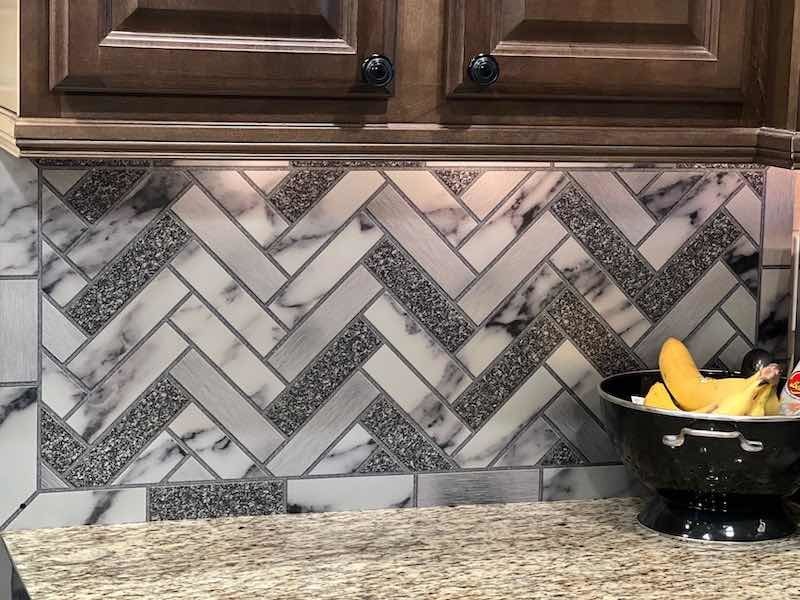Photos don’t lie, but when it comes to anodized aluminum, they can certainly make images believable.
 Reiner GoertzenReiner Goertzen, president of Mareiners in Oregon, came up with a patent to impregnate anodized coatings with high-quality digital images, which we profiled in an article in 2021. His latest product is one that is making recreational vehicle manufacturers take notice.
Reiner GoertzenReiner Goertzen, president of Mareiners in Oregon, came up with a patent to impregnate anodized coatings with high-quality digital images, which we profiled in an article in 2021. His latest product is one that is making recreational vehicle manufacturers take notice.
Goertzen has taken a photo that he created of a tiled backsplash and anodized it onto aluminum, resulting in a very durable product that some RV makers are using instead of the actual more expensive tile and grout, which is often costly and time-consuming to install.
But at first, he had no takers about a year and a half ago when he presented the idea of a photo backsplash to an OEM trailer manufacturer in Oregon.
Needing Something 'New and Different'
 Goertzen has taken a photo that he created of a tiled backsplash and anodized it onto aluminum, resulting in a very durable product that some RV makers are using instead of the actual more expensive tile and grout, which is often costly and time-consuming to install.“I told them about my process and presented it to them, and it was dead for a little while,” Goertzen says. “Then I got a phone call from them about eight months ago, and they said they were in dire need of something new and different.”
Goertzen has taken a photo that he created of a tiled backsplash and anodized it onto aluminum, resulting in a very durable product that some RV makers are using instead of the actual more expensive tile and grout, which is often costly and time-consuming to install.“I told them about my process and presented it to them, and it was dead for a little while,” Goertzen says. “Then I got a phone call from them about eight months ago, and they said they were in dire need of something new and different.”
The RV maker, Northwood Manufacturing, had actually switched some time ago to a glass-etched backsplash from Italy but told Goertzen their supplier dried up and they want something different instead.
“Obviously, with glass, it shakes going down the road, and it cracks in the mounting, or the technician mounting it in the trailer will crack it,” he says. “There’s a lot of rejects and quality issues that they had with the current product, and they wanted obviously something a lot more durable and a lot more fire resistant.”
Goertzen’s process produces a permanent image embedded within the anodized coating and can be applied to a multitude of shapes without adding undesirable surface thickness, whereas powder coating and/or silk screening process adds thickness to the surface and isn’t as durable with a high-resolution 3D image.
Previously, his company had made significant inroads in the credit card industry, the sporting goods sector — which wanted to anodize camouflage images instead of painting them — as well as the medical industry, where images of the actual medical tool and other artwork could be anodized into parts that were sanitized in an autoclave and reused often.
Sublimating Hi-Res Image Film on Aluminum
The process of applying the image and sealing the anodized part is very similar to the normal anodizing process. But instead of the part going to the dye tank to be colored, the parts are sent to an area where Goertzen’s patented process sublimates the hi-res printed image film onto the part before it goes back to the anodizing line to be finished and sealed.
After removing the part from the anodizing tank, it is rinsed and then dried to prepare it to receive the image, which is printed using specialized sublimation inks and papers so that the inks that comprise the image will sublimate onto the part, where the inks will flow into the pores in the anoxic surface.
The image is transferred to the part through a sublimation process using a press that is heated and applies constant, even pressure between the paper and the part so that the entire area of the image is in pressurized contact with the part.
Goertzen makes money on the product by licensing the technology to anodizing operations around the U.S. that have a need for it to satisfy customer requirements.
3D Appearance That Deceives the Eye
 After removing the part from the anodizing tank, it is rinsed and then dried to prepare it to receive the image, which is printed using specialized sublimation inks and papers so that the inks that comprise the image will sublimate onto the part, where the inks will flow into the pores in the anoxic surface.For the backsplash product, Goertzen worked with his graphic designer to create a high-resolution image of a backsplash. The result is a very realistic appearance that includes shadow lines, so to have a 3D appearance that is deceiving to the eye that it is not actually tiles and grout.
After removing the part from the anodizing tank, it is rinsed and then dried to prepare it to receive the image, which is printed using specialized sublimation inks and papers so that the inks that comprise the image will sublimate onto the part, where the inks will flow into the pores in the anoxic surface.For the backsplash product, Goertzen worked with his graphic designer to create a high-resolution image of a backsplash. The result is a very realistic appearance that includes shadow lines, so to have a 3D appearance that is deceiving to the eye that it is not actually tiles and grout.
“With the shadows, the image messes with your eye and gives depth,” he says. “When you look at that grout, it looks like it is recessed with actual granules of sand. So every person that sees this permanently anodized image on aluminum, the first thing you want to do is touch it.”
With the new product line, Goertzen started a company called Eagle Cap Distributors, where he is buying the aluminum out of Yakima, Washington, and driving it to a new licensee in Boise, Idaho, who is performing Goertzen’s patented anodizing process.
Goertzen is headed to Elkhart, Indiana, soon to meet with two of the largest RV Distributors that supply the RV who have an interest in the process and the products it can produce. He says the OEMs are interested in using the anodizing product — instead of wood or other material — because of durability, fire resistance, and the option to change the image very easily.
“One thing the OEMs liked is you can have several thousand of these backsplashes in inventory, and at the end of the year, if you don’t use them, you can send them back to us, and we can strip the image off and put another one on it,” he says.
A ‘Remarkable Finish’
 Dwayne DayleyDwayne Dayley, the owner of Sapphire Metal Finishing in Caldwell, Idaho, is the anodizer who has been working with Goertzen on the backsplashes, something he says he knew would be a big opportunity when he first saw them.
Dwayne DayleyDwayne Dayley, the owner of Sapphire Metal Finishing in Caldwell, Idaho, is the anodizer who has been working with Goertzen on the backsplashes, something he says he knew would be a big opportunity when he first saw them.
“I own a trailer myself, and the backsplashes are always a pain,” says Dayley, whose company offers specialized aluminum anodizing and conversion coatings.
“Depending on which trailers you look at, the backsplashes are either too heavy, they’re cheap, they break, or they are hard to clean,” Dayley says. “The list goes on. They do not have got a really great solution for something that moves down the road. But this is a great solution, and when he showed me what he had, I thought, ‘Problem solved.’”
Sapphire Metal Finishing has become a licensee of Goertzen’s anodizing application, and Dayley says he invested in the equipment and license because he sees a big upside to the process. Now it is just a matter of more manufacturers accepting the photo finish process to grow the market.
“The final product just looks so real because it is an anodized photo and looks amazing. When the RV people first saw it, they couldn’t believe what they were seeing. They had to go up and touch it; it is a remarkable finish.”
“Reiner called us a couple of years ago, and we said, ‘Nah,’” Dayley says. “He called me back and asked us to look at it again. We saw what he was doing, and that’s when we decided to partner with him. It solves a very specific problem.”
Sapphire Metal Finishing has made about 700 of the backsplashes so far. Dayley says after his team worked out the kinks in the process and learned how to sublimate the parts properly, they had no problem getting the production line running smoothly.
“The final product just looks so real because it is an anodized photo and looks amazing,” he says. “When the RV people first saw it, they couldn’t believe what they were seeing. They had to go up and touch it; it is a remarkable finish.”
Consultant Helping to Manage License Process
 Goertzen has also brought on as a consultant Keith Jennings, who is retired as the licensing manager for Realtree Outdoors, the largest camouflage company in the U.S. Jennings started using Goertzen’s products several years ago and was sold on the idea of image anodized products replacing those which had to be painted because of the durability.
Goertzen has also brought on as a consultant Keith Jennings, who is retired as the licensing manager for Realtree Outdoors, the largest camouflage company in the U.S. Jennings started using Goertzen’s products several years ago and was sold on the idea of image anodized products replacing those which had to be painted because of the durability.
“When we were looking to anodize aluminum with high-definition camo patterns, nobody could do it, and nobody could maintain the colors and the integrity of the image that we demanded,” Jennings says.
When he met Goertzen about the project years ago, he challenged him to solve the anodized camo image issue.
“I said, ‘If you really want to do something, solve this problem for us,’” Jennings says. “Sure enough, it was four months later, and he called me up, and he said I got that process you were asking about.”
Goertzen says he believes the image-anodizing process has grown into a wide array of industries over the past 20 years of offering his process. The issue is selling the licenses to enough anodizing facilities to build up capacity, as well as creating the demand for more products that can be image anodized using the images to replace current products on the market.
Finding More Anodizers to Adopt Process
The license is a $35,000 one-time payment and includes free training for five days and the additional equipment needed to apply the process. It is looked at as a major investment by anodizers; Hardcoat Inc. in Minneapolis says they spent close to $300,000 on a license and extra equipment to start applying Goertzen’s process and remodeled his building, but it has started to pay big dividends.
“For Keith and I, that’s been the biggest problem,” Goertzen says. “A lot of anodizers in the U.S. are super interested in the process, but they’re like, ‘Bring me a product, and I’ll run with it, and then I’ll get licensed.’”
“When you present it to them, it’s fun to see their faces, and they’re like, ‘What do you mean you can put an image into aluminum, and you can’t scratch it off?’”
Part of the solution is that Goertzen is working to educate anodizers on the capabilities of the imaging process so that they can have discussions with their own customers about what the process can do for them, thus creating more industries and sectors that can utilize it.
“We need to get anodizers to start looking for products to image-anodize,” Goertzen says. “Many of the current customers at anodize facilities just don’t know that the process exists.”
Goertzen is working on other products, too. One of the RV Manufacturers asked if he could make aluminum look like wood, to which Goertzen responded with “No problem.”
“Wood-looking kick plates, steps, and wainscoting would be a huge deal in the industry,” Goertzen says. “When you present it to them, it’s fun to see their faces, and they’re like, ‘What do you mean you can put an image into aluminum, and you can’t scratch it off?’”
Visit http://mareiners.com



































